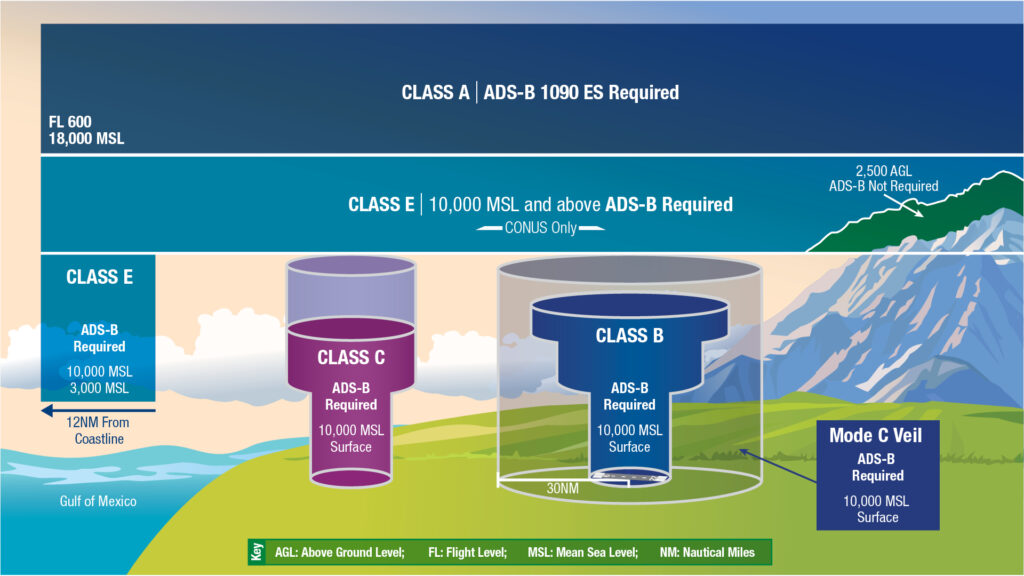Overview of FAA Airspace Classifications
The Federal Aviation Administration (FAA) organizes U.S. skies into different airspace classes to maintain safety, manage air traffic, and protect public interest. Each classification has specific altitude ranges, entry requirements, and Air Traffic Control (ATC) rules. Understanding these differences is essential for any pilot, whether flying under Instrument Flight Rules (IFR) or Visual Flight Rules (VFR). You’ll also need to know VFR weather minimums, required equipment (i.e. ADS-B/Mode C), and speed limits by class.
Class A, B,C, D, and E Airspace Explained
Class A Airspace
- Altitude: 18,000’ MSL up to and including FL600.
- Operations: IFR only
- Requirements: Continuous two-way communication with ATC; Mode C transponder, and ADS-B Out required.
Class B Airspace
- Shape: “upside down wedding cake” around the busiest airports, surface to typically 10,000’ MSL.
- Entry: ATC clearance required before entry.
- Weather Minimum: 3 statute miles visibility, clear of clouds.
- Equipment: Mode C transponder and ADS-B Out required inside the Class B and within the 30-nautical mile “Mode C veil” (common trap for pilots).
- Speed Limits: Less than or equal to 250 KIAS below 10,000’ MS; less than or equal to 200 KIAS within 4-nautical miles of the airport at/under 2,500’ AGL, as well as in VFR corridors/underlying shelves.
Class C Airspace
- Shape: Surface to 4,000’ AGL within 5-nautical miles core, plus 1,200’ to 4,000’ AGL within a 10-nautical miles shelf.
- Outer Area: ATC provides radar services within a 20-nautical mile radius.
- Entry: Must establish two-way radio communications, you must hear your callsign from ATC before entering.
- Equipment: ADS-B Out and Mode C required within/above Class C up to 10,000 MSL.
Class D Airspace
- Altitude: Surface to 2,500’ AGL (charted in MSL).
- Airports: Surrounds smaller towered airports.
- Entry: Must establish and maintain two-way communication with the tower (hearing your callsign).
- Notes: Reverts to Class E or G when the tower is closed (check Chart Supplement or NOTAMs).
- Equipment: ADS-B/Mode C only required if inside of Mode C veil or above 10,000’ MSL.
- Speed Limits: Less than or equal to 200 KIAS within Class D.
Class E Airspace:
- Definition: Controlled airspace not classified as A-D.
- Floors: Can begin at the surface, 700’ AGL, 1,200’ AG, or 14,500’ MSL. Extends up to but not including 18,000’ MSL, and resumes at/above FL600.
- Operations: IFR clearance required; VFR has no radio requirement.
- Equipment: ADS-B Out required at/above 10,000 MSL (except within 2,500’ AGL of the surface).
- Watch the floor of Class E carefully, if it starts at the surface or 700’ AGL, there’s less Class G below.
Controlled vs Uncontrolled Airspace

Controlled airspace includes Class A through E, where ATC provides varying levels of traffic management and separation. In Class B, C, and D airspace, VFR pilots must obtain and maintain the required communication or clearance and then comply with all ATC instructions. In Class E, VFR pilots are not required to talk to ATC, but if communication is established, they must follow any instructions given.
Uncontrolled airspace, Class G, has no ATC services. Pilots are fully responsible for navigation, collision avoidance, and self-announcing when appropriate on Common Traffic Advisory Frequency (CTAF).
- VFR Weather Minimum in Class G (example): Below 1,200’ AGL during the day = 1 statue mile visibility and clear of clouds.
Why Airspace Knowledge Matters for Every Pilot
Navigating airspace correctly prevents violations, improves safety, and builds pilot confidence. Whether operating in dense Class B airspace or rural Class G, knowing entry requirements, altitude limits, and communication protocols is a critical skill.
Take Your Airspace Knowledge to New Heights with MzeroA Online Ground School
Love our videos and eager to learn more about the skies you fly in? Whether you’re passionate about aviation or just starting your flying journey, now is the perfect time to deepen your understanding. With a 2-week FREE trial of MzeroA Online Ground School, you can explore FAA airspace rules, ATC procedures, and real-world flying strategies in detail. Think of it as your “discovery flight” into MzeroA’s courses, see firsthand how we make complex concepts like Class A through G airspace clear, simple, and practical for pilots at every level. Visit www.mzeroa.com/trial for more information!
